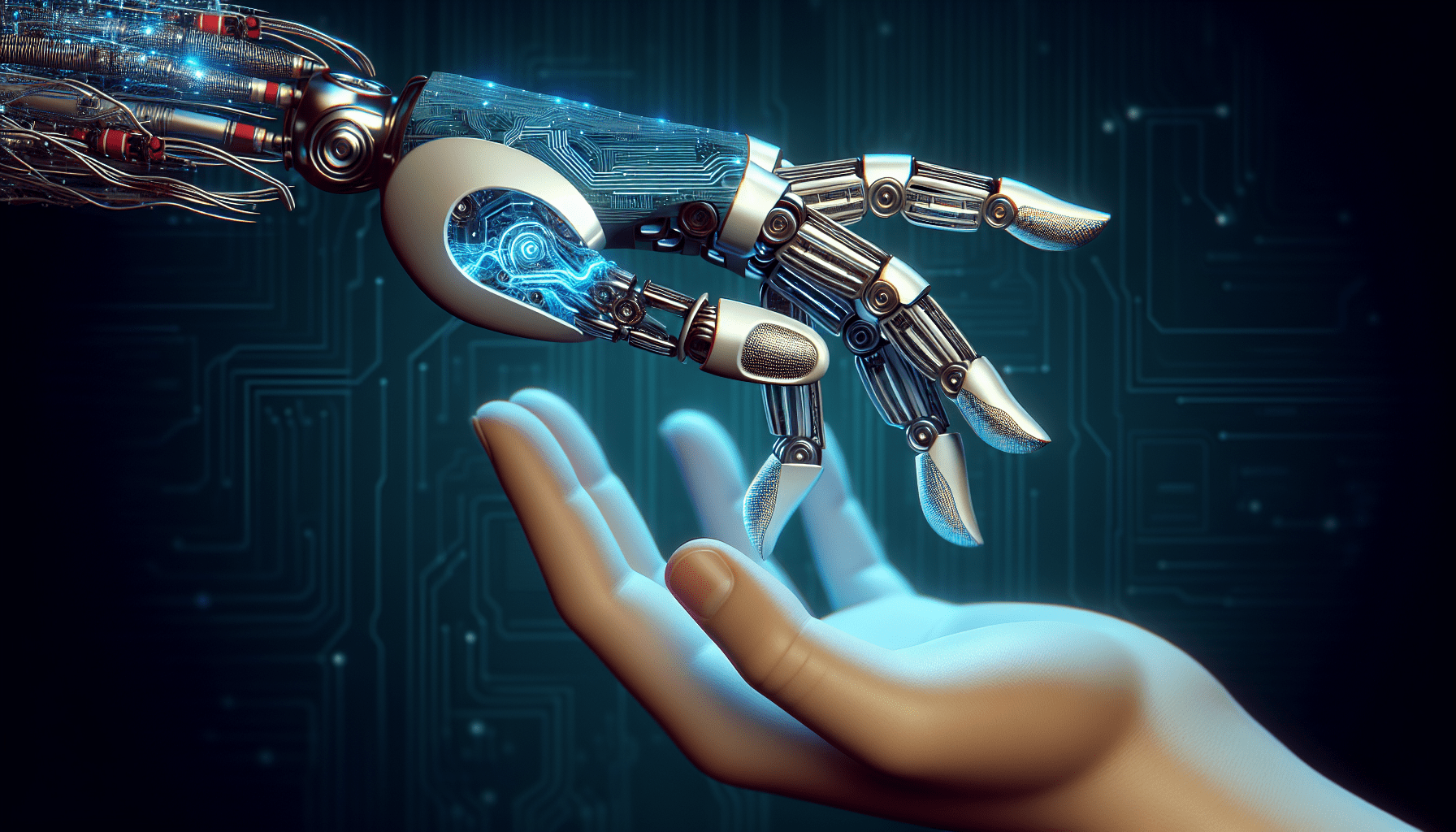Are you feeling overwhelmed by the buzz around artificial intelligence (AI)? Wondering what it’s all about and how it can impact your life? Look no further than “AI for Newbies: A Beginner’s Guide.” In this handy guide, we’ll break down the basics of AI in a friendly and approachable way, so even if you’re a complete novice, you’ll come away with a better understanding of this exciting technology. So, let’s get started on this AI adventure together!
What is AI?
Definition of AI
Artificial Intelligence (AI) refers to the simulation of human intelligence in machines that are programmed to think and learn like humans. These machines are designed to perform tasks that would typically require human intelligence, such as speech recognition, decision-making, problem-solving, and pattern recognition.
AI technology aims to create computer systems that can comprehend, reason, and learn from their experiences, just like a human brain. This involves the use of algorithms, data, and computational power to imitate human intelligence and improve the efficiency and accuracy of various tasks.
History of AI
The history of AI can be traced back to the mid-20th century when the concept and study of AI began to emerge. In 1956, a group of researchers coined the term “artificial intelligence” and organized the Dartmouth Conference, which is widely considered as the birthplace of AI.
Over the years, AI has witnessed various breakthroughs and milestones. In the early stages, AI focused on logical reasoning and problem-solving. In the 1970s and 1980s, expert systems and knowledge-based AI techniques gained prominence. The late 1990s and early 2000s saw a surge in machine learning and data-driven approaches.
Today, with advancements in computing power and big data, AI has become more powerful and pervasive in our lives. It is now being applied across various industries and sectors, revolutionizing the way we live and work.
Types of AI
Narrow AI
Narrow AI, also known as weak AI, is designed to perform a specific task or set of tasks within a limited scope. It focuses on solving well-defined problems and is trained to excel in a narrow domain. Examples of narrow AI include voice assistants like Siri and Alexa, image recognition systems, and chatbots.
Narrow AI systems are trained using large datasets and sophisticated algorithms to mimic human-like capabilities in a specific area. While they exhibit impressive performance in their respective domains, they lack the ability to generalize or transfer their knowledge to other tasks or domains.

General AI
General AI, also known as strong AI or human-level AI, refers to machines that possess the ability to understand, learn, and apply intelligence to any intellectual task that a human being can do. It encompasses a broad range of cognitive abilities, including reasoning, judgment, problem-solving, and creativity.
Developing general AI is a complex challenge, as it requires machines to have a comprehensive understanding of the world and the ability to learn from diverse experiences. While general AI remains a distant goal, researchers and scientists continue to work towards developing machines that can match or surpass human intelligence.
Superintelligence
Superintelligence refers to AI systems that surpass human intelligence in virtually every aspect. These machines have the ability to outperform humans in complex decision-making and problem-solving tasks. Superintelligence is considered to be the most advanced form of AI, capable of surpassing human capabilities across multiple domains.
The notion of superintelligence has been a subject of both excitement and concern among researchers and experts. While the potential benefits of superintelligent AI are vast, there are also ethical and existential concerns associated with its development. Ensuring the safe and responsible deployment of superintelligence is crucial to prevent any unintended consequences.
Applications of AI
Virtual Assistants
Virtual assistants have become increasingly popular in recent years. These AI-powered applications, such as Siri, Alexa, and Google Assistant, use natural language processing and machine learning algorithms to understand and respond to user commands.
Virtual assistants can perform various tasks, such as answering questions, setting reminders, playing music, and controlling smart home devices. They continue to improve with time, learning from user interactions and adapting to individual preferences. Virtual assistants have become an integral part of many people’s daily lives, making tasks more convenient and efficient.

Automated Customer Support
AI has transformed customer support by automating various tasks, such as answering common inquiries, providing personalized recommendations, and handling routine transactions. Chatbots, powered by natural language processing and machine learning algorithms, can interact with customers and resolve their queries in a timely manner.
Automated customer support systems not only save time and resources for businesses but also improve the overall customer experience. By leveraging AI, companies can provide 24/7 support, reduce wait times, and ensure consistent and accurate responses to customer inquiries.
Recommendation Systems
Recommendation systems are widely used in online platforms to personalize user experiences and enhance product discovery. These systems analyze user behavior, preferences, and historical data to provide personalized recommendations for products, services, and content.
AI-powered recommendation systems are employed by e-commerce websites, streaming platforms, and social media platforms to suggest relevant items and engage users. By leveraging machine learning algorithms, these systems continually learn from user interactions and adapt their recommendations to individual preferences, leading to improved customer satisfaction and increased sales.
AI in Everyday Life
Smartphones and Voice Assistants
AI has become an integral part of smartphones through the integration of voice assistants like Siri, Google Assistant, and Bixby. These voice-driven AI applications make it easier for users to perform tasks, get information, and interact with their devices using natural language voice commands.
Smartphones equipped with AI capabilities can perform a range of tasks, including voice recognition, image recognition, and predictive typing. They can also provide personalized recommendations, reminders, and suggestions based on user behavior and preferences. AI-powered smartphones have revolutionized the way we communicate, access information, and interact with technology.

Social Media Algorithms
Social media platforms leverage AI algorithms to curate personalized feeds, recommend content, and target advertisements. These algorithms analyze user behavior, preferences, and interactions to display content that is most likely to engage and resonate with users.
AI-powered social media algorithms track user interests, connections, and online behavior patterns to provide a tailored experience. By showing relevant content and advertisements, these algorithms aim to keep users engaged, increase user retention, and drive revenue for the platforms.
Online Shopping and Personalization
AI has significantly transformed the online shopping experience through personalized recommendations, targeted advertisements, and efficient product search. E-commerce platforms use machine learning algorithms to analyze user preferences, purchase history, and browsing behavior to suggest relevant products and improve search results.
By leveraging AI, online retailers can provide personalized product recommendations, offer targeted promotions, and enhance the overall shopping experience. With AI-powered personalization, users are more likely to discover products that align with their preferences, leading to increased customer satisfaction and higher conversion rates.
Ethics and Concerns of AI
Unemployment and Job Displacement
One of the primary concerns surrounding AI is the potential impact on employment. As AI technology continues to advance, there is a fear that machines and automation could replace jobs traditionally performed by humans, leading to unemployment and job displacement.
While AI may eliminate certain jobs, it also has the potential to create new job opportunities. AI can enhance productivity, automate repetitive tasks, and enable humans to focus on more complex and creative endeavors. However, proactive measures need to be taken to reskill and upskill the workforce to adapt to the changing job landscape.

Privacy and Data Security
With the increasing reliance on AI and the collection of vast amounts of personal data, privacy and data security have become significant concerns. AI systems require access to large datasets to train and improve their performance, raising questions about data privacy and how this information is used and protected.
It is crucial to ensure that proper safeguards and regulations are in place to protect user data and prevent unauthorized access or misuse. Companies and organizations must prioritize data security, implement robust encryption measures, and establish transparent data handling practices to maintain trust and privacy in AI-driven systems.
Bias and Fairness
AI algorithms are built upon datasets that reflect existing human biases, leading to potential biases in AI systems. If these biases are not addressed, AI can perpetuate and amplify societal biases, leading to unfair and discriminatory outcomes.
To mitigate bias in AI, it is essential to have diverse and representative datasets, conduct thorough testing and evaluation of algorithms, and implement transparency and accountability in AI decision-making processes. Ethical considerations must be incorporated into AI development to ensure fairness, minimize bias, and promote equitable outcomes.
Learning AI
Online Courses and Tutorials
There are numerous online courses and tutorials available for individuals interested in learning AI. Platforms like Coursera, edX, and Udacity offer specialized AI courses taught by leading experts in the field. These courses cover various topics, including machine learning, deep learning, natural language processing, and computer vision.
Online courses provide a structured learning environment, offering instructional videos, assignments, quizzes, and forums for students to interact and seek guidance. They allow individuals to learn at their own pace and gain a comprehensive understanding of AI concepts and techniques.

AI Programming Languages
To work with AI, it is crucial to have knowledge of programming languages commonly used in AI development. Python, a versatile and beginner-friendly language, is widely used in AI for its extensive libraries and frameworks dedicated to machine learning and AI.
Other languages commonly used in AI include R, Java, C++, and Julia. These languages provide robust frameworks, libraries, and tools for building AI models and applications. Familiarizing yourself with these programming languages will enable you to develop AI solutions and algorithms efficiently.
Joining AI Communities
Joining AI communities is an excellent way to connect with like-minded individuals, share knowledge, and collaborate on AI projects. Online platforms, such as Kaggle and GitHub, provide forums, repositories, and resources where AI enthusiasts and professionals can learn from each other and work on real-world AI problems.
Attending AI conferences and meetups is another great way to network with experts and stay updated on the latest advancements and trends in the field. Engaging with the AI community can offer valuable insights, foster collaboration, and accelerate learning in the world of AI.
AI in Business
Automation and Efficiency
AI technology offers businesses the potential to automate repetitive tasks, streamline processes, and improve overall operational efficiency. By leveraging AI, businesses can enhance productivity, reduce costs, and allocate resources more effectively.
AI-powered automation can handle large volumes of data, analyze patterns, and make predictions, enabling businesses to make data-driven decisions and optimize operations. From inventory management to customer relationship management, AI can transform various aspects of business processes, leading to increased efficiency and competitiveness.
Predictive Analytics
Predictive analytics is a powerful application of AI that allows businesses to forecast future outcomes and trends based on historical data and patterns. AI algorithms analyze large datasets, identify relevant variables, and create predictive models to make accurate predictions and actionable insights.
Through predictive analytics, businesses can anticipate customer behavior, optimize marketing campaigns, forecast demand, and make strategic decisions. By leveraging AI algorithms for predictive analytics, businesses gain a competitive edge by understanding market trends and adapting their strategies accordingly.
AI-powered Chatbots
AI-powered chatbots have become increasingly popular in customer service and support. These chatbots use natural language processing and machine learning algorithms to engage with customers, answer inquiries, and provide personalized recommendations.
AI-powered chatbots can handle a high volume of inquiries simultaneously, reducing wait times and improving customer satisfaction. By automating routine customer interactions, businesses can free up human resources to focus on complex and value-added tasks, enhancing overall customer service and support capabilities.
AI in Healthcare
Medical Diagnosis
AI has shown significant potential in medical diagnosis by analyzing patient data, medical records, and imaging data to detect and diagnose various diseases. AI algorithms can learn from vast amounts of medical data to identify patterns and anomalies, aiding in accurate and timely diagnoses.
By leveraging AI in medical diagnosis, healthcare professionals can improve the efficiency and accuracy of diagnoses, leading to better patient outcomes. AI can assist in identifying diseases at an early stage, recommending appropriate treatment plans, and optimizing healthcare delivery.
Drug Discovery
AI is revolutionizing the field of drug discovery by expediting the identification and development of new drugs. AI algorithms analyze vast amounts of data, including genetic information, molecular structures, and clinical trial data, to identify potential drug targets and predict the efficacy of candidate compounds.
By accelerating the drug discovery process, AI has the potential to bring new therapies to market more quickly and improve treatment options for various diseases. AI-powered drug discovery enables scientists to explore a broader range of possibilities and make data-driven decisions, revolutionizing the pharmaceutical industry.
Personalized Medicine
AI is playing a crucial role in advancing personalized medicine, tailoring treatments and therapies to individual patients based on their genetic makeup, lifestyle, and medical history. By analyzing patient data and patterns, AI algorithms can predict treatment responses, identify potential side effects, and recommend personalized treatment plans.
Personalized medicine allows healthcare providers to deliver targeted and precise treatments, improving patient outcomes and reducing adverse reactions. Through AI-driven personalized medicine, the healthcare industry can move towards more precise and effective healthcare interventions.
AI in Education
Personalized Learning
AI is transforming education by enabling personalized learning experiences tailored to individual students’ needs, abilities, and learning styles. AI-powered educational platforms leverage adaptive algorithms and data analytics to identify knowledge gaps, provide targeted feedback, and adjust the pace and difficulty of learning materials.
By personalizing the learning experience, AI helps students stay engaged and motivated, fostering a deeper understanding of concepts and improving academic performance. AI-powered educational tools open up new avenues for students to learn at their own pace and receive individualized support.
Intelligent Tutoring Systems
Intelligent Tutoring Systems (ITS) utilize AI algorithms and techniques to provide personalized tutoring and coaching to students. These systems analyze student performance data, identify areas of improvement, and offer targeted guidance and support.
ITS can simulate a one-on-one tutoring experience, providing tailored instruction, feedback, and challenges based on individual learning needs. By leveraging AI, ITS enhances student engagement, comprehension, and knowledge retention, making learning more effective and enjoyable.
Automated Grading
AI has the potential to automate the grading and assessment process, saving teachers time and effort. AI-powered grading systems can evaluate assignments, exams, and essays using predefined criteria and algorithms, ensuring consistency and unbiased grading.
Automated grading systems can quickly analyze large volumes of student work, provide timely feedback, and generate detailed performance reports. This allows teachers to focus more on instructional activities and personal interaction with students, enhancing the overall teaching and learning experience.
Future of AI
Advancements in Robotics
Advancements in AI are driving the development of more sophisticated and capable robots. AI-powered robots can perform complex tasks, manipulate objects, navigate environments, and interact with humans with increasing ease and adaptability.
AI-driven robotics has the potential to revolutionize various industries, such as manufacturing, healthcare, and agriculture. From autonomous vehicles to robotic assistants, AI-powered robots are set to transform the way we live and work in the future, improving productivity, efficiency, and safety.
AI in Space Exploration
AI is playing a significant role in space exploration, enabling autonomous navigation, data analysis, and decision-making in extreme and remote environments. AI algorithms can process and analyze vast amounts of data from space missions, identifying patterns and anomalies that humans may overlook.
With the help of AI, spacecraft can adapt to changing conditions, make real-time decisions, and execute complex maneuvers. AI-powered space exploration promises to expand our understanding of the universe, support scientific discoveries, and pave the way for future space missions.
Ethical Considerations
As AI continues to advance, ethical considerations become increasingly important. There are concerns regarding the responsible development and deployment of AI, ensuring that it aligns with human values, respects privacy, and avoids harmful consequences.
Ethical considerations include addressing biases in AI algorithms, ensuring transparency and accountability in decision-making processes, and upholding human rights and values. Ongoing research, debate, and regulatory frameworks are necessary to guide the ethical development and use of AI, ensuring a future where AI technologies enhance the human experience.
In conclusion, AI has become an integral part of our lives, impacting various sectors and offering immense potential for innovation and growth. From virtual assistants and recommendation systems to healthcare and education, AI is transforming industries and revolutionizing the way we live and work. As we navigate the future of AI, it is crucial to address ethical concerns, promote fairness and inclusiveness, and continue advancing AI technologies responsibly to leverage its full potential for the benefit of humanity.






Leave a Reply